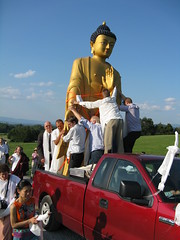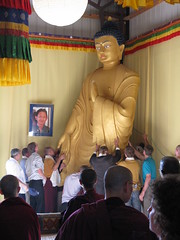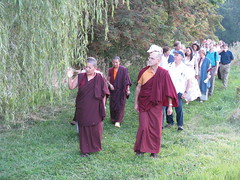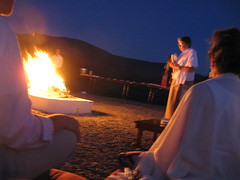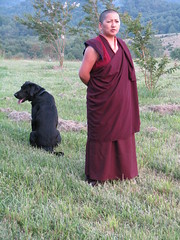Saturday, May 14, 2011
First reminder-The Precious Life - Khandro Rinpoche
Sunday, April 24, 2011
Talk on Guru Yoga - Lopon Andre, Lotus Garden, February 2011
As usual, any mistakes, errors, or corruptions are all my fault.
________________________________________________
Monday, October 12, 2009
October Already????, Some wisdom on being an 'elder' from Khandro Rinpoche
A quick update. Last month, I was able to make it for 3 1/2 days of the Khandro Rinpoche Annual Retreat, and one additional practice day at Lotus Garden. The teachings were mostly about phowa (ejection of consciousness at the moment of death) and What to Do When You Are Dead - an explanation of the Bardo. While there are said to be six Bardos, or in-between states - the Bardo of Meditation, the Bardo of Dreams, the Bardo of the moment of Death, the Bardo of Dharmata, the Bardo of Becoming, and the Bardo of this Life- when people say "the Bardo", it usually refers to that state after the moment of death until the next rebirth (if one buys into that sort of thing).
I can't repeat exactly what she said in those teachings, since they are restricted. This must be understood correctly. "Restricted" doesn't mean that if you hear these teachings, or if I repeated them here, one's face would melt like that one Nazi at the end of "Raiders of the Lost Ark". :) It means that, if one hasn't had the preceding teachings, which give the background for understanding what is occurring, then one would read them and go, "WTF"??? Without the context, they wouldn't make any sense.
Those of you who would like to know about the Bardo, I can send you to some excellent resources on-line here, here, here and here.
However, I thought it should be ok if I share a little bit she said about what it is to be a dharma elder. For those of us who have been at this dharma thing for over a decade (as I have now, since the first retreat I did with Khandro Rinpoche - which to me is really the beginning of when I got serious about Dharma (and also, since it was the first time I took refuge vows, it technically marks my becoming a follower of Buddha's way too)- it is important to think about the importance of discipline for elders. and her explanation of how compassion comes out of emptiness:
"...as elders who hold titles, dharma is given more in action than spoken works. The elders in this sangha must always make sure their actions are diverging from ordinary way... We need to be a step ahead in better conduct, maturity, generosity, kindness, simplicity, revulsion, unifying meditation and post-meditation. The conduct of discipline and self-awareness enhances one's own understanding and unifies the view and meditation. One becomes a wish-fulfilling jewel for others. Your conduct itself becomes a strengthened voice for dharma."
"Seeing the nature as is should allow you to become more free in embracing everything. Having a glimpse of shunyata (emptiness/fullness) mind and then forcing non-reaction to appearances doesn’t sound correct. (having an understanding of) “All appearances are mind “ should give more freedom to all appearances. This is a freedom to be involved, a flexibility with which you do not grasp to that moments’ expression. Rather than force abiding in shunyata, (one should) always bring about a supple way of freeing everything from your grasping, since you realize there is nothing to discriminate. Non-conceptual compassion is about this. 'You know things are a projection of your mind, but you take a bug outside (that is inside trapped flying against a screen)" is a beautiful expression of samboghakaya non-dual compassion. “
"(One should) Play along with saving lives, cooking food, all the mundane things like being important at a meeting, being a servant, mother, father, etc. And, you do (all these tasks) well, because you have no agendas, no discrimination. If the ending works, fine. If it is most tragic, fine. Kind of blah, fine. You simply play along with it."
"You must learn to flow. The river doesn’t stop at every place it sees a beautiful meadow and says, “I want to stop here”. You most flow, there is no need of grasping. Being willing to flow by itself is compassion. To be non-conceptual, things must not be made more than it is. That would only be solidifying it. "
"Make aspirations each day. Live well. Prepare for death. If that happens, go forward with confidence."
So, that is what I have been thinking about since the Annual Retreat. It's an odd thought, that I am an elder now. Following both from what Rinpoche said above and from the view of my other lineage, the Drikung Kagyu, discipline/ethics is a VERY important part of the whole thing. Not only for one's own good (since w/o discipline, one won't get far - one will get distracted easily, for starters), but also for everyone else.
Khandro Rinpoche has said in the past something along the lines of (paraphrasing broadly here) "you are likely the only Buddhist practitioner that most people you meet will ever meet. So, think - does your way of manifesting speak well of the Dharma? If YOU met yourself, would you think, "Here is someone who seems genuine, who acts according to what he/she talks about, maybe there is something to this path" and be inspired to start sitting, cutting your actions that are really only harming yourself, etc.? Or would you think, "This person is a bit of a mess. I don't think this buddhism stuff must work too well" and then turn away from the potential for using this human life to benefit others, rather than focusing solely or one's own desires (or on "self-aggrandizing", as the Drikung Khenchen Rinpoche likes to say)".
There is a great responsibility here to try to be the teachings. I admit to massive FAIL on that front sometimes, but I am certainly much better than I once was. Now that I have my own students, I hope that I am an inspiration for them to go further in training their own minds.
...And that's it for today. :)Tuesday, September 9, 2008
A Sample of Khandro Rinpoche - Introduction to Milarepa Movie
Monday, August 25, 2008
How the Black Swan Came to the Lake...
* This is the "one damn song that can make me break down and cry", as David Bowie once put it.
Monday, August 18, 2008
Back from Retreat - Final version
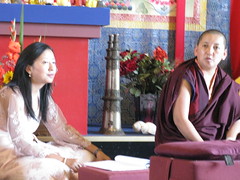
I got there for the end of the "Entering the Vajrayana" portion (which, to be completely honest, related to my current practice more than the following week). She was continuing her teachings from last year about the nine yanas (10, if you include the "Samsaric yana of Gods and Men", which she did).
At one point, when talking about the Four Reminders, Rinpoche dropped this little gem:
"Many of us, w/o seeing impermanence, waste our lives doing a lot of things.
It’s now 2 weeks and a day since Lucinda died. When that happened, many of you thought briefly about your own mortality. Even if you came and wept in front of wherever, I’m not convinced it will be long lasting. Teachers die, sangha members die, you get a tumor. 70% of our sangha are dealing with some issue at this moment.
Occasionally, that other 30% are reminded that this could happen to you, but there is more thought in defying impermanence than thinking about it."
___________________________________________________________
This year, the main teaching for the Dzogchen section of the retreat was a practice of Chod, or "cutting through". This is a practice of literally offering the one thing we are all most attached to - our very body - to various unseen beings. It's unique for several reasons.
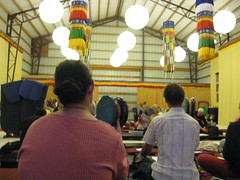
However, the genius of Machig Lapdron, the inventor of Chod (more on her shortly), was to combine these old techniques with the profound view of emptiness, as well as the specifically Buddhist aspiration to cut clinging to a "self". Basically, she bridged the two traditions to create a powerful way to cut grasping to the self, which is the biggest hindrance to enlightenment.
One other big thing was that the inventor of Chod was an actual living human female. Sadly, like most of the religious traditions on this planet, Tibetan buddhism also has an anti-female slant to the whole thing that developed over time. Shakyamuni himself said that women were just as likely as vessels for enlightenment as men. (This was after many requests, however - which is understandable, since Shakyamuni Buddha still had to live among 'normal' people, and the idea that women were also capable of being religious practitioners was very radical in it's time. It could have lead some more conservative elements to turn violent on him.)
A couple year ago, Rinpoche transmitted a short Chod practice, with one melody. It was a very good thing I brought my bass guitar this year, which came in VERY handy to try to remember the SIX different melodies used in the 40+ pages of this Chod. If I can get it under my fingers, I can remember the melody.
Also, as previously mentioned, a 17-foot buddha statue from Mindrolling monastery in India arrived in the Port of Baltimore that week. 10 or so guys from the Retreat with no serious injuries (which ruled me and my two herniated disks out) drove down and picked up the 600+ pound (ok, 'Kilogram') statue. Here's some shots of it.
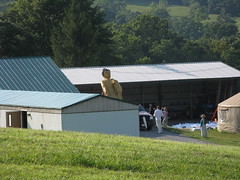
Right - The statue went up (very slowly) by truck to the main shrine room, where it will stay until the new shrine down by the lake is finished. It was balanced on the back of a pickup truck precariously.
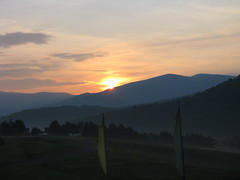 We ended the week with a 2 day Drupcho (extended practice) of the Vajrasattva sadhana. This was partially to mark 21 days after the death of Lucinda Peach. It was also to bless the future site of the new temple.
We ended the week with a 2 day Drupcho (extended practice) of the Vajrasattva sadhana. This was partially to mark 21 days after the death of Lucinda Peach. It was also to bless the future site of the new temple. At the end of the Drupcho, Rinpoche broke us into 4 groups, and each group did the Fire Puja part of the text in the four cardinal directions at the new temple site.
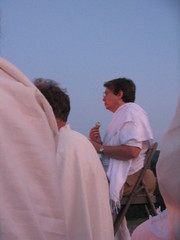
I was lucky enough to be in the group with Loppon Jann Jackson leading (right). To see her in action like that was awesome. I think she totally embodied Vajrasattva. Plus, her advice to those of us there to "not get fascinated by what you see - you've all seen rice before, you've all seen Crisco before - but instead hold the view. Remember to hold the view!" was spot on perfect.
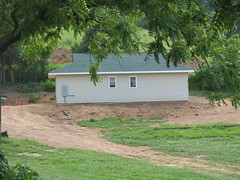 While there, I stayed in the new dorm building (right), which was 'finished' the first weekend I was there. (Ok, the plumbing for the toilet and shower were not finished yet, but as Rinpoche says, we should all "be flexible".)
While there, I stayed in the new dorm building (right), which was 'finished' the first weekend I was there. (Ok, the plumbing for the toilet and shower were not finished yet, but as Rinpoche says, we should all "be flexible".)Gordon Ryan did a great job of ensuring this thing was built right. For fellow energy geeks, the insulation between the roof and ceiling is R-60. Even on the hottest day, it stayed comfortably cool inside the building (with no AC!)
I have had this weird feeling that some kind of karmic blowback is long overdue personally, since my practice has been going so well the last several months, which led me to go sit on the porch of the main shrine room (a converted barn) at night a few nights. There was a full moon during the Retreat (which is considered an auspicious occurance), so it was easy to see where I was walking even without my headlamp.
I still have this feeling of some impending heartbreaking event coming soon, which will really, really test what I have worked on in solitary retreat. Some may say I'm pessimistic, I'd say I'm realistic...Shakyamuni didn't say "Life is Suffering" just to hear himself speak...
(ok, so I'm using this as an excuse to show off some of my David Lynch-esque mood photography. So sue me...:))
 | 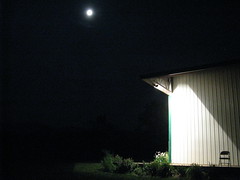 | 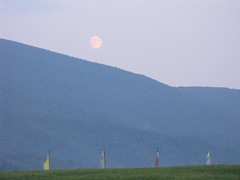 |
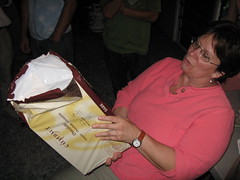
For example, here's one of Rinpoche's best students (Well, it -is- true, Judy-la :)) starring down what appears to be the Largest Chocolate Bar in the World. This was later melted down and served to everybody on french toast...yummmmmmmm.....
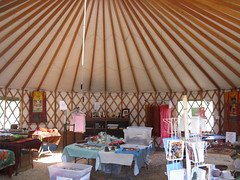
Someone donated a yurt to Lotus Garden, which became the site of "Ratna in the Round", the complete one-stop shop for all your dharma supply and gift needs. Julie Heeggard, in addition to her skills in running the Baltimore Shambhala Center, also turns out to be a great slick salesperson - often crossing over (quite willingly, I'd say) into parody (I'll have to dig up a photo of the "Miracle Rocks" she was selling :) in a successful attempt to get fellow students to buy stuff to support Lotus Garden.
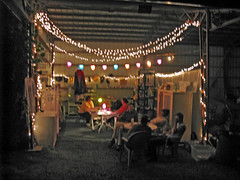
And, every night, people were hanging out at the Ratna Kosha, Kosha Cabana...during the day, she was doing brisk business selling ice cream. (Everything is empty, yes, but those pounds I added at Retreat from empty calories sure seem real...:))
That's all for now.
Oh, and in the mundane world, I have a second interview next week. We'll see what happens...
-JTR/LWWD
Friday, August 8, 2008
Off to the Land of Lotuses...
Tuesday, July 22, 2008
"what is the purpose of that retreat? "
Well, Stac, to answer your question, I figured it'd be worth posting to this here blog (which is currently read by occasional VKR sangha members and my dog, though I doubt she - quite - gets all the meaning :)).
What is the purpose of retreat?
Well, in a Buddhist context, there are really two kinds of retreat: study and practice. Most retreats in the West are some combination of the two, since most of us are not living in either a monastic or a dharma household situation (which is how many non-monastic lamas in the Nyingma lineage of Vajrayana Buddhism, who have families after years of training,will teach).

Traditionally, one would be getting teachings on an on-going basis where they lived, and "retreat" would mean a time when they would go off by themselves to practice according to the instructions of their teacher until some realization occurred.
However, since the majority of the sangha in the Americas and Europe are lay practitioners, study has to be concentrated into retreat situations also. As Khandro Rinpoche has said many times, it's not an idea situation for transmitting the dharma, but it's what we are stuck with given our lives.
As people who have been reading this know, I did 5 1/2 weeks of personal retreat time a couple months ago, allowing the teachings to sink into the core of my being. As a famous chant of the Kagyu lineage starts, "Grant your blessings so that my mind may be one with the Dharma".
This allowed me to tame my mind enough so it could be focused on the teachings (via shamatha - calm abiding meditation), and then:
1) go over parts of the teachings enough (through vipasyana, which leads to the creation of prajna - transcendental wisdom) so that my worldview and my conduct actually reflect that part of the teachings, versus my usual samsaric habits, which haven't really served me so well up til now, and will most likely not lead to a positive long-term result in the future; and
2) do other practices which will lead to a similar transformative effect.
What I am supposed to be doing starting August 8th is going to a retreat that is mostly teachings-oriented lead by Her Eminence Mindrolling Jestun Khandro Rinpoche (along her younger sister Jetsun-la, a great translator with FAB-ulous clothing tastes, and many nuns from her retreat center/nunnery in India Samtense).
This is the continuation of several streams of teachings that Rinpoche has been teaching on an ongoing basis every year (now going on 11 years). Every year, she teaches a certain set of teachings in several different sections for groups of practitioners with different levels of practice and study.
Being on a land retreat center like Lotus Garden, where a majority of practitioners stay on the land (either in dorm spaces or in tents) instead of leaving at the end of a day of teachings to go back their usual homes (as happened at Khandro Rinpoche annual retreats when they happened in Baltimore up until 2003), allows teaching of another kind to take place.
With everybody living in close quarters, people tend to run up against each other all the time. Especially since many of us have known each other for a long time (in my case, almost a decade), we get to know each others quirks, and see how we relate to them.
People in these situations tend to come up to the point of sometimes getting sick at other's little eccentricities, sometimes falling totally in love with fellow practitioners after they get to know them deeper and deeper, and sometimes come up against their own neurosis along the lines of "I wish I had something different to eat"; "I don't want to do this job during work periods, I want to do his/her job instead", "I MUST ask this question of Rinpoche (which usually turns out to not be nearly so important as it seemed)", "why does it seem everybody in this dorm snores like a chainsaw?", "I wish we had private showers", etc. blah blah blah.
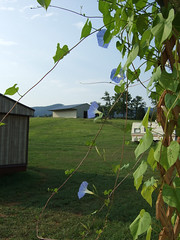
I myself have had all these happen personally. (FYI, Falling for female friends over the years has been my worst personal worst fault as long as I can remember - it has made things extremely awkward at times, but in most cases we've been able to deal with that and get beyond it. The emotions never seem to quite go away, but we have been blessed with many skillful methods to work with them instead of repressing (which leads to all kinds of guilt and neurosis - trust me, I know it:)) or acting out (which usually tends to lead to words and actions people later regret.) Before I met with the Dharma, there is no way that there would be any kind of happy resolution to these situations beyond "and now, here's the part where I disappear and put a lot of substances into my body to try to convince myself I don't care." That last method really doesn't have much to it that I would recommend. I would go so far as to say that it is a really, really crappy way to attempt to carry on.
The "working through it" part is where "the rubber hits the road", so to speak. When these little situations come up, it throws us into situations where we have to work with our minds, as instructed by Rinpoche and other teachers.
The great thing about it happening in a place like Lotus Garden is that in your normal life, you don't have:
1) the inspiration and the strange modification to the atmosphere of a place that having one's Teacher present creates; and
2) one's MI (Meditation Instructor) and/or other senior students one trusts to talk to about when things get weird, to keep people going in the direction of basic sanity, versus the usual samsaric "bbbbbllllaggghhhhh!"
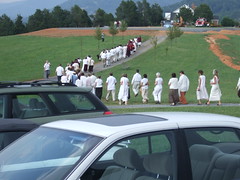
In these somewhat controlled conditions, one can change their habitual patterns of dealing with situations. I've found that if one has done so in a retreat environment, then it becomes much easier to do it again in the "real world".
These little adverse circumstances are, in many ways, just as important as teachers as one's human teachers.
As for the streams of teachings being given, I wil personally attending part of the "entering the Vajrayana" section and most of the "Dzogchen" section of the Retreat this year. Dzogchen - aka Dzogpa Chenpo, which translates as "The Great Perfection" - is the pinnacle of the teachings of the Nyigma lineage, which is the oldest lineage of Himalayan Buddhism, aka Tantric Buddhism, aka Tibetan Buddhism, aka the Vajrayana ("Diamond-like Vehicle").
It encompasses a series of very powerful practices that, if practiced correctly under the guidance of a qualified master, can get pretty much anyone with the mental faculties, opportunity, and inclination enlightened.
If one is just trying to do the methods (for example, the widely talked about "Fire of Tummo/ Kundalini" practice) from a book or without proper guidance, however, one can end up at best wasting their time or at worse drive themselves stark raving mad.
This path has been compared to a supersonic jet - If one gets on with the properly trained pilot and crew, one can fly to the city of enlightenment much faster than anyone else. However, if one does not have a properly trained crew in the cockpit, for example if it is like you trying to fly from a manual, then there is a great risk of a spectacular crash and burn before reaching your destination.
The tantras* that contain the Dzogchen methods are pretty wild. This tradition forces one to see the nature of their own mind in many unique ways.
At the actual Retreat itself, the daily schedule is usually as follows:
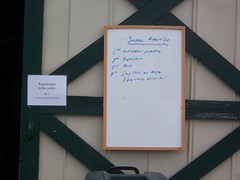
6 AM (or so) - personal practice session
7:30 AM- everyone - Opening prayers, aspirations and practices to orient out minds properly for the day
8:30 AM- breakfast
9:30 AM- work period
10:30 AM - first teaching session with Rinpoche
12:30-1 PM- lunch
2 PM - 2nd teaching session with Rinpoche
5 PM- everyone - afternoon "Protectors' practice (which I'll cover later on)
6PM - dinner
7:30 PM -either 3rd teaching session with Rinpoche or a review/ Q&A session with some of the Senior students (people who have been practicing this stuff correctly for 20-30 years)
9:30 PM-personal session
10:30 PM- bed
It is a pretty intense schedule, which is has to be to pack in everything RInpoche is teaching. It must be remembered, she is trying to give us the lifeblood of her lineage's teachings of view, conduct and meditation in their entirety year by year. Transmitting the Dharma in an authentic way to Westerners is quite a challenge. Fortunately, teachers like Khandro Rinpoche (and also Sakyong Mipham Rinpoche, Khenchen Konchog Gyaltshen Rinpoche, Tulku Thondup Rinpoche, to name a few I have been around myself) are up to the challenge.
The real question mark is, Are WE up to it?
Stay tuned.
Also, it must be mentioned that we aren't ALL just study study practice. We study hard, and practice hard, but we also play hard.
Khandro Rinpoche knows how to have fun too, and likes to remind us western students to not take ourselves too seriously.
In years past, ways of blowing off steam have included:
- a talent (-less? :)) show, featuring some of the -ahem- senior students doing a very involved parody of "Iron Chef" based around the mystery ingredient of tsampa (a nearly flavorless roasted barley powder that is the staple of the Tibetan diet), and some young residents of Lotus Garden blasting their ways through a Poison cover (I am not sure how they could sing with their toungues so firmly in their cheeks :));
- setting off nearly commercial grade fireworks;
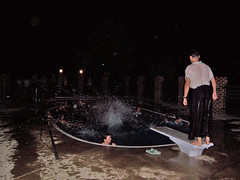
- an occasional movie night, featuring films that haven't hit America yet, like the original of "the Grudge";
- water balloon fights, with a large portion of the sangha jumping fully clothed in the pool the previous owner of the land had installed;
- handing out ice cream to everyone in the shrine room;
- golf kart racing; and
other silly stuff.
No alcohol is involved, and nothing even remotely sexy occurs (except maybe occasionally someone prancing around in a toga :)). But it's not as solemn an occasion as some might imagine a Buddhist retreat would be.
Well, that's about it for this time. Hopefully, it "helped confusion dawn as wisdom", rather than more confusion. :)
Read up for more details:
http://www.lotusgardens.org/programs/AnnualRetreat08.cfm.
-LWWD
*I'll save my "Tantra is NOT about 'Amazing Fucking" rant for a later posting. :)

